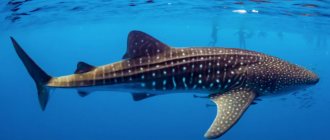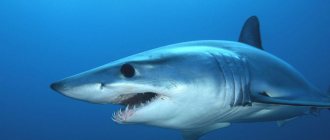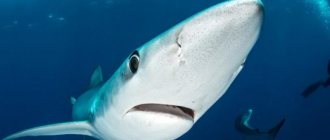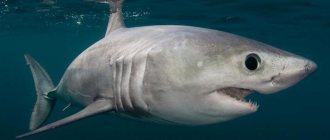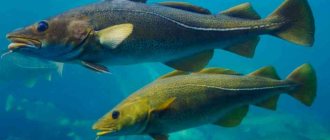- Wild animals
- >>
- Fish
Today it is difficult to meet a person who has never heard of such an animal as the great white shark .
This ancient and unique animal is shrouded in a trail of danger and mystery, in which modern cinema and the media have played a significant role. Is this really a cruel and merciless killer who preys on people? Why does the great white shark take pride of place among the most dangerous creatures on the planet? Interest in this mysterious person continues to this day. There is another interesting underwater predator - the whale shark. Read it, you will like it.
Origin of the species and description
Photo: White shark
The modern scientific world cannot come to a consensus on the question: where did great white sharks come from on Earth? Proponents of one theory believe that this is a direct descendant of the oldest giant fish - megaladon, which became extinct about 3 million years ago. The alleged ancestor had incredible dimensions that are difficult to even imagine today - 30 m in length and a body weight of more than 50 tons.
Representatives of the opposing theory of the origin of white sharks are confident that this unique animal has survived to this day thanks to the evolution of one of the extinct shark subspecies - the mako. Both predators belong to the herring shark family and have a similar tooth structure. The white shark, or as it is commonly called, carcharodon, is a cartilaginous fish whose skeleton does not have hard bones, but consists entirely of soft and elastic cartilage. Thanks to its streamlined body, reminiscent of a combat torpedo in shape, this shark belongs to the order Lamniformes.
Despite numerous disputes related to the origin of the great white shark, the world scientific community is unanimous in one thing - it is an ancient, dangerous, aggressive and extremely intelligent predator, the study of which continues to this day. And the more dangerous the object of research, the more interesting it is to observe it.
Appearance and features
Photo: White shark teeth
The great white shark has a powerful, agile, streamlined, torpedo-shaped body that allows it to move at incredible speeds. The massive cone-shaped head is bordered by small, far-set eyes and a pair of nostrils. Two small olfactory grooves lead to the nose of the predator, which allows it to smell the slightest fluctuations in water and the smell of prey at a distance of several kilometers.
The dorsal and caudal fins of the white shark are of outstanding size and often become visible on the surface of the water. The lateral, anal and ventral fins are visually less pronounced, as in all representatives of this genus of fish. Five deep gill slits are located directly behind the head on both sides and provide the breathing process.
The color of the great white shark does not quite live up to its name. The dorsal and lateral parts of the animal are most often dark gray, brown, blue or even green. This allows the shark to become as invisible as possible in the water column. But the belly of a sea predator is almost always white or milky.
Among the outstanding features that put the white shark on a par with other most dangerous predators on the planet are the following:
- huge size;
- an adult white shark at its peak reaches 4–5 meters in length;
- females are usually much larger than males;
- The average body weight of a predator ranges from 700 to 1000 kg. However, history knows of cases of encounters with sharks 7, 10 and even 11 meters long. There are legends about the incredible size of this storm of the seas. To date, the largest white shark caught is officially considered to be a specimen caught in a herring net off the coast of Canada in 1930. The length of this individual was 11 meters 30 centimeters;
- a wide mouth armed with razor-sharp teeth. The great white shark has a total of about 300 teeth. They have serrations on the sides, allowing their owner to cut prey quickly and deftly, as if with a saw or an ax. The teeth are arranged in several rows - most often there are five. Over the entire lifespan of a shark, its teeth are completely renewed several times;
- absence of a swim bladder. This feature forces the white shark to constantly move without sleep or rest, so as not to drown.
Assault on a person
People are not of interest to sharks, although there have been many recorded cases of them attacking. The most common victims are divers and fishermen who get too close to the predator.
In the waters of the Mediterranean Sea, a “shark phenomenon” has been observed, according to which Carcharodons swam away after one bite. According to experts, sharks that are hungry can easily feed on humans.
Most often, when meeting sharks, people die from blood loss, drowning or painful shock. When attacking, predators injure their prey and wait for it to weaken.
Playing dead is the worst option when encountering a shark.
Solo divers can be partially eaten by a shark, but people who dive with partners can be saved. Often those people who actively resist are able to escape. Any blows can cause the predator to swim away. Experts advise, if possible, to hit the shark in the eyes, gills, and face.
It is important to constantly monitor the location of the predator; it may attack again. Sharks readily feed on carrion, so the sight of an unresisting victim will not stop them.
This is interesting: What do chinchillas eat at home and in the wild?
Where does the great white shark live?
Photo: Mouth of a white shark
The great white shark lives in almost all oceans of our planet, with the exception of the Arctic.
Most often, this dangerous predator can be found in the following locations:
- South Coast of California;
- Coast of South Africa;
- Mexico;
- Australia;
- New Zealand.
Most white sharks prefer to stay on the surface of water warmed by the warm rays of the sun to 15-25C. The most shocking attacks of these sea hunters have been recorded in shallow water. They rarely go deep or into the cold waters of the open ocean, but this does not mean that they cannot be found there.
One of the characteristics inherent in the great white shark is its ability, or even passion, for long migrations. Scientists have recorded cases where some individuals traveled incredibly long distances from one continent to another and back. The true reason for such movements is still unknown. This can be either a craving for procreation or a search for shores richer in food.
In general, the white shark is quite unpretentious in its habitat and breeding environment. Few other marine inhabitants can compete with her in terms of hunting, so she can feel like a master of the situation in any waters of the world's oceans.
Habitats
The shark's habitat is all coastal waters. It is not found only in the Arctic Ocean and near Antarctica on the Russian side. Most of the fish live off the coast of California and near the island of Guadeloupe. A small number of predators can be observed near Croatia and Italy, as well as off the coast of New Zealand. Small flocks listed in the Red Book swim here.
Scientific research and observations have been carried out near Dyer Island, where schools of white sharks regularly appear . Fish also live near:
- Madagascar;
- Kenya;
- Mauritius;
- Seychelles.
Since the animal is unpretentious in food, it does not need to migrate in different seasons of the year. But the shark focuses on places where there are optimal conditions for reproduction and where you can enjoy new food. Large individuals live in coastal waters, where there are many sea lions, seals, whales and other bony inhabitants of the deep sea. In size, predators can only compete with larger killer whales.
What does a great white shark eat?
Photo: White shark dimensions
There is an opinion that a shark is capable of eating anything, regardless of taste and size. This is partly true; there have been cases when the most unexpected objects were found in the stomachs of great white sharks - from glass bottles to underwater bombs. However, if we talk about the animal diet of these fearless predators, then, first of all, fish and shellfish of various breeds and sizes come to the fore. Young individuals eat large quantities of small, but nevertheless fatty and nutritious herring, sardines and tuna. As the white shark matures, it becomes more difficult to handle small whales, the bottlenose dolphin, fur seals and sea lions, as well as other sharks.
It is surprising that such a skilled hunter will never refuse carrion, and the shark can smell its indescribable aroma from several tens of kilometers away. One large, decaying carcass of a dead whale can feed a white shark for about a month. Of particular interest is the hunting skill of the great white shark. When lying in wait for a fur seal, a predator can swim for a long time in the water column, as if not noticing the prey, and then suddenly jump to the surface, grabbing the prey in the death grip of its powerful jaws. This action is very spectacular and amazes with its technicality.
The hunt for a dolphin is no less surprising - the shark slowly swims up to it from behind, thereby blocking the dolphin’s ability to echo location. This is one of the indisputable proofs of the presence of quite developed intelligence among these ancient predators.
Interesting Facts
White sharks have not yet been studied enough, but they are an important part of the ocean ecosystem, so a decrease in their numbers will negatively affect the food chain. Still, the researchers were able to identify several interesting facts about this predator:
- females have thicker skin, otherwise they would not be able to reproduce normally;
- the teeth of all individuals are coated with fluoride;
- all five senses are well developed in them;
- olfactory receptors allow them to hear prey at a distance of up to 3 km;
- When hunting in cold waters, predators independently increase their body temperature.
During mating, males hold their partner roughly and bite her fins, so females have thicker skin as they develop. Fluoride prevents shark teeth from deteriorating from the acid released by caviar and small bacteria. Vision, hearing, smell, sensitivity to water fluctuations and taste buds are better developed in predators than in other marine inhabitants.
The shark population has been greatly reduced by industrial fishing. There are too few of their habitats left on the map of the World Ocean. If the rapid extinction of predators begins, this will lead to the disappearance of some underwater plants.
Features of character and lifestyle
Photo: Great white shark
It is generally accepted that the great white shark is a solitary predator. In general, this is true, however, when it comes to coastal hunting, sharks can gather in schools of two to five individuals. This temporary group has one alpha leader, and the remaining members perform clearly assigned roles. This organization is very similar to the hunting of a wolf pack.
As for the hierarchy among white sharks, the situation here is in the best traditions of matriarchy. Females dominate males due to the fact that they significantly exceed them in size. Conflicts within a social group are resolved at the level of demonstrative punishment in the form of mild, warning bites.
Unlike its counterparts, the great white shark is sometimes able to lift its head out of the water in order to better see its prey and generally scout out the situation. This extraordinary skill of the sea predator is often depicted in documentaries and feature films about wildlife, thanks to which the role of a cold-blooded and calculating killer is firmly established for the white shark. White sharks are rightfully considered to be long-livers underwater. Most of them live up to 70 years or more, unless, of course, they fall into the nets of poachers or are eaten by other, even more bloodthirsty predators.
Lifespan
Ichthyologists from all over the world are trying to determine the exact period and life expectancy of the shark. She is about 70 years old. The vertebrae of the found specimens were examined. 4 sharks took part in the analysis and the following data was obtained, allowing us to find out how long sharks live: male - 73 years, female - 40.
There is no exact data on how many years sharks live, but it can be said that their average life cycle is 30-50 years.
Social structure and reproduction
Photo: The largest white shark
Great white sharks prefer to be alone for much of their lives. Their authoritative nature does not tolerate competition and rivalry; they are ready to agree only to short-term cooperation for the sake of a big jackpot in the form of a sea lion or a school of dolphins. Females will never yield to males the role of alpha in the social group. An interesting fact is that cannibalism occurs from time to time among white sharks.
Once, a company of Australian fishermen had the opportunity to watch a terrifying sight: one six-meter shark in an instant bit another, smaller individual in half.
Great white sharks take quite a long time to mature for procreation. Typically, they develop the ability to reproduce only by the age of 30 in females and by the age of 25 in males. These marine predators belong to the category of egg-bearing viviparous fish. This means that the shark carries eggs fertilized by the male throughout pregnancy in its womb until the moment of birth.
The body of a female white shark is designed to carry from two to twelve embryos at the same time. However, already in the womb, these future conquerors of the seas initially behave like natural-born killers. Stronger individuals eat the weaker ones, so that by the time of birth, usually only two or three cubs remain alive.
The gestation period for a great white shark lasts a full eleven months. After birth, young individuals immediately begin to hunt on their own and are absolutely not attached to their mother. Unfortunately, not all cubs are destined to live to see their first birthday. The ocean is cruel and does not tolerate weakness. All these factors, including long puberty, long gestation periods, and low birth rates, are one of the fundamental reasons for the impending extinction of this rare animal species.
World record for giants caught
The largest shark ever captured by humans was caught in Pakistani waters off Baba Island in 1949. Its length was 12.55 meters and its weight was 20 tons. At its widest point, the circumference of the body was 7 meters.
The giant was a whale shark. Unfortunately, the harpooners killed the fish and then sold the carcass in parts.
Watch video - The largest shark caught in the world:
Natural enemies of the great white shark
Photo: White shark
Few people would dare to pretend to be the sworn enemy of such a formidable predator as the great white shark. However, nature is very wise and for every action there is always a counterforce. If we analyze life in the ocean in detail, we can identify several natural “enemies” of the white shark:
- other sharks - as already noted, these predators do not disdain cannibalism, or can inflict a mortal wound on their relative in the process of competition;
- killer whales - this species of whale is the most dangerous for both sharks and other inhabitants of the ocean. They are agile, intelligent, sociable and very strong. The outcome of the fight between a killer whale and a white shark will most likely be unpredictable.
- urchin fish - this seemingly harmless inhabitant of the deep sea can cause the painful death of a great white shark. When caught in the mouth of a predator, the hedgehog fish swells to an impressive size, injuring the shark’s throat. In addition, its body is covered with poisonous thorns, which gradually leads to intoxication and painful death of the predator.
- man - unfortunately, in today's civilized society there are often cases of deliberate killing of great white sharks for the sake of their fins, teeth, ribs or idle curiosity. In addition, these sea predators have firmly established the reputation of a man-eater shark, which further provokes aggression from humans. Indeed, cases of attacks on people are not so rare, but it is worth noting the fact that divers, surfers and fishermen do not comply with basic safety precautions in the habitats of white sharks. The fact is that from the depths, a person sailing on a board or boat looks very similar to a sea lion or a seal. The shark simply confuses people with its usual prey.
Population and species status
Photo: Giant white shark
Today, the total population of great white sharks is approximately 3,500 individuals. Most of these white-bellied predators settled near Dyer Island (South Africa). It is here that numerous ichthyological studies are carried out, thanks to which we know so much about the lifestyle of this species of shark.
It’s embarrassing to admit, but at the moment this majestic ancient animal is on the verge of extinction. A third of the total population of great white sharks is exterminated by humans due to stupidity, greed and ignorance. Shark fins are credited with healing properties; some doctors predict their ability to defeat cancer and other deadly diseases.
Among the South African natives, killing a white shark is considered the highest sign of courage. The teeth of a defeated animal often become a totemic decoration. The general aggressive attitude towards these marine inhabitants is inspired by numerous stories about the most severe attacks of white sharks on people. However, is it right to blame wildlife for the fact that we ourselves are treacherously invading its territory? The answer is disappointing and has already been recorded on the pages of the International Red Book. White sharks continue to disappear and this process probably cannot be stopped.
